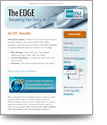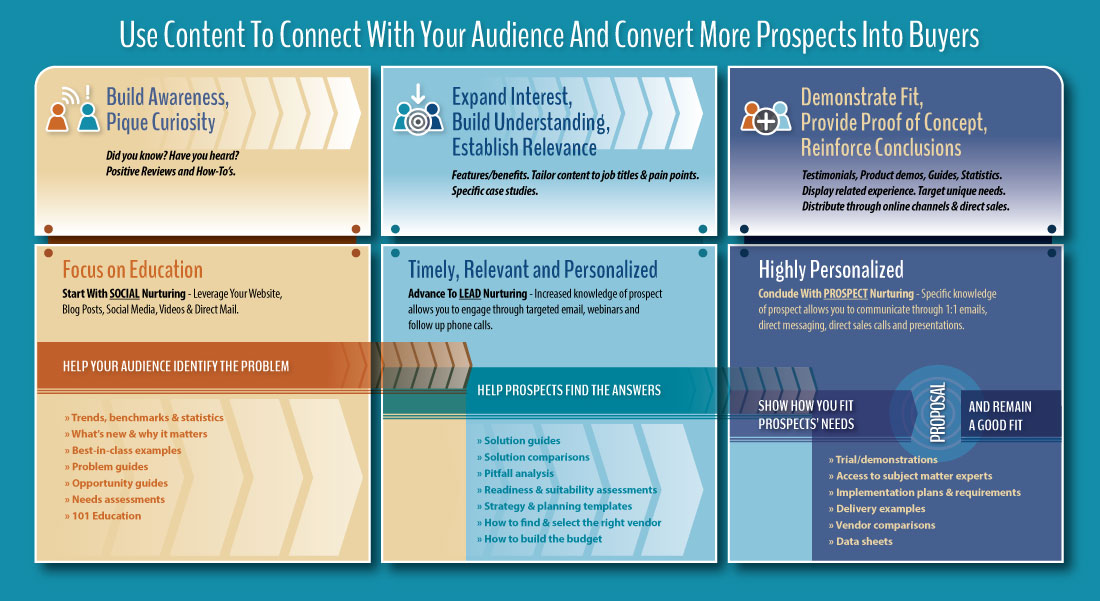
B2B buyers are not impulse purchasers.
Sales cycles continue to get longer, and involve more decision makers. The business buyer generally researches a product or service and competitive vendors before putting a proposed purchase into a budget plan. The plan itself may take time to be approved, or may need to cycle through annual budgeting. And, the buyer with high accountability for purchases will be cautious.
Research from MarketingSherpa found that 70% of leads generated by marketing are “longer-term opportunities worth nurturing.” If you use nurturing to maintain your mindshare with the prospect, you have a chance to shape buying criteria and expectations, positioning your company as the one most able to deliver desired outcomes.
2.Communication can be a key differentiator.
A study conducted by the Bridge Group found it takes an average of seven touches to convert a “suspect” to a “prospect.” In some complex sales, with enterprise-level customers and CXO buyers, it often takes between nine and 11 touches before a deal closes.
These touches are often steps along an educational path, with the buyer slowly accumulating the knowledge necessary to make a decision. Where the handoff between sales and marketing happens depends on your process, but make sure not to leave gaps. One thing is clear: Don’t quit communicating too early.
3.The discard pile often contains money cards.
According to benchmark research from SiriusDecisions, 80% of the prospects deemed “bad leads” by sales teams do go on to buy within 24 months.
The lead who’s not ready to buy now (but is interested) may just wander off to another vendor – if you don’t keep them warm and engaged with personalized communication and education. Companies ignoring these longer-term leads are handing over opportunities to their competitors.
4.Nurtured leads often end up being more profitable.
The Aberdeen Group report “Lead Nurturing: The Secret to Successful Lead Generation” found Best-in-Class organizations see double the bid/win ratio on nurtured leads, compared to peer organizations.
A Lenskold study notes that 28% of marketing teams using marketing automation reported an increase in the average deal size from a marketing qualified lead that was passed to sales; the credit goes to the stronger relationships resulting from nurturing and educating buyers.
5.Leaky funnels are a drain on ROI measures.
Too often leads wind up in limbo. Ignored by marketing, not accepted by sales, they languish and either fade away… or just find another vendor. Automated lead nurturing makes it easy to keep pace with the lead, helping them progress through the buyer’s journey without a manual strain on your resources. Advanced organizations track where prospects fall out of the buying cycle, and use this data to shore up shortfalls in the nurturing process.
Keeping leads alive and nurturing them reduces your cost per lead, increasing profitability.
Managing the long sales cycle: If you’re going to keep a deal alive over the course of a long sales cycle, you need to keep the customer relationship alive and healthy. Nurturing lets you establish a rhythm of contact and keep the communications line open with ongoing touchpoints.
The marketing and sales teams can work together to deliver a mix of emails, videos, infographics, white papers, invitations to events, and/or phone calls. Your best approach will likely be some combination of several channels. One big plus for using marketing automation to do this is automating the heavy lifting of what to send when, and making sure communications go out on schedule.


 Insight Delivered Directly to You Interesting topics, great offers and free marketing tools.
Insight Delivered Directly to You Interesting topics, great offers and free marketing tools.

